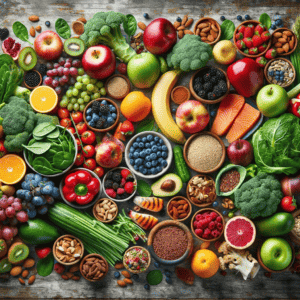
What Should I Eat When Taking Semaglutide?
What Should I Eat When Taking Semaglutide? Semaglutide (Ozempic, Wegovy) is a medication that has gained popularity in recent years for its ability to promote healthy eating habits. It is a glucagon-like peptide-1 (GLP-1) receptor agonist that works by mimicking the effects of a hormone called GLP-1, which is naturally produced in the body.
Semaglutide helps to control appetite and cravings, making it easier for individuals to make healthier food choices and maintain a balanced diet.
In this article, we will explore the importance of proper nutrition for overall health and wellness, and how Semaglutide can play a role in promoting healthy eating habits.
Understanding the Importance of Proper Nutrition for Your Body
Proper nutrition is essential for maintaining overall health and wellness. The food we eat provides our bodies with the necessary nutrients, vitamins, and minerals to function properly.
A balanced diet that includes a variety of fruits, vegetables, whole grains, lean proteins, and healthy fats can help prevent chronic diseases such as heart disease, diabetes, and obesity. Additionally, proper nutrition can improve energy levels, support a healthy immune system, and promote mental well-being.
A balanced diet consists of macronutrients (carbohydrates, proteins, and fats) and micronutrients (vitamins and minerals).
- Carbohydrates provide energy for the body, while proteins are essential for building and repairing tissues.
- Fats are necessary for hormone production and nutrient absorption.
- Fruits and vegetables are rich in vitamins and minerals that support various bodily functions.
By consuming a variety of nutrient-dense foods, individuals can ensure that their bodies are receiving all the necessary nutrients for optimal health.
The Role of Semaglutide in Promoting Healthy Eating Habits
Semaglutide plays a crucial role in promoting healthy eating habits by controlling appetite and cravings. It works by binding to GLP-1 receptors in the brain, which helps to regulate hunger and satiety signals. By mimicking the effects of GLP-1, Semaglutide can reduce appetite and cravings, making it easier for individuals to make healthier food choices and stick to a balanced diet.
Incorporating Semaglutide into a diet plan can be beneficial for individuals who struggle with overeating or emotional eating. By reducing appetite and cravings, Semaglutide can help individuals feel more satisfied with smaller portions and make healthier food choices. This can lead to weight loss and improved overall health.
How Semaglutide Helps Control Appetite and Cravings

Will I Still Get All The Nutritional Value I Need On Semaglutide?
The science behind Semaglutide’s appetite-suppressing effects lies in its ability to mimic the effects of GLP-1. GLP-1 is a hormone that is released in the intestines after a meal. It signals to the brain that the body is full and helps regulate appetite and food intake. Semaglutide works by binding to GLP-1 receptors in the brain, activating them and prolonging their effects.
Real-life examples have shown how Semaglutide has helped people control their cravings and make healthier food choices. Individuals who have incorporated Semaglutide into their diet plan have reported feeling less hungry throughout the day and experiencing fewer cravings for unhealthy foods. This has allowed them to stick to a balanced diet and achieve their weight loss goals.
The Best Foods to Fuel Your Body with Semaglutide
When incorporating Semaglutide into your diet plan, it is important to focus on consuming nutrient-dense foods that are compatible with the medication. Nutrient-dense foods are those that provide a high amount of nutrients relative to their calorie content. These foods can help fuel your body and provide the necessary nutrients for optimal health.
Some examples of nutrient-dense foods that are compatible with Semaglutide include:
- Fruits and vegetables are rich in vitamins, minerals, and fiber.
- Whole grains provide complex carbohydrates for sustained energy.
- Lean proteins such as chicken, fish, and tofu are essential for building and repairing tissues.
- Healthy fats found in avocados, nuts, and olive oil are necessary for hormone production and nutrient absorption.
Incorporating these foods into your diet plan can help ensure that you are getting all the necessary nutrients while taking Semaglutide. It is important to focus on portion control and listen to your body’s hunger and fullness cues.
Incorporating Semaglutide into Your Daily Diet Plan – What Should I Eat When Taking Semaglutide?

Healthy Foods
What should I eat when taking Semaglutide? Incorporating Semaglutide into your daily routine can be done by following a step-by-step guide. First, it is important to consult with a healthcare professional to determine the appropriate dosage and duration of Semaglutide treatment. They can provide guidance on how to incorporate the medication into your diet plan.
Next, it is important to create a meal plan that includes nutrient-dense foods and portion control. This can be done by planning meals and snacks in advance, and ensuring that each meal includes a balance of carbohydrates, proteins, and fats.
It may be helpful to track your food intake using a food diary or a mobile app to ensure that you are staying on track with your goals.
Meal preparation can also be beneficial when incorporating Semaglutide into your daily routine. By preparing meals in advance, you can ensure that you have healthy options readily available and reduce the temptation to reach for unhealthy foods.
It may be helpful to batch cook meals and portion them out into individual containers for easy grab-and-go options.
The Importance of Hydration and Semaglutide
Hydration plays a crucial role in Semaglutide’s effectiveness. Staying hydrated can help prevent constipation, which is a common side effect of Semaglutide. It is important to drink an adequate amount of water throughout the day to ensure proper digestion and elimination.
Tips for staying hydrated while taking Semaglutide include drinking water throughout the day, carrying a water bottle with you, and setting reminders to drink water. It may also be helpful to incorporate hydrating foods such as fruits and vegetables into your diet plan.
Combining Semaglutide with Exercise for Optimal Health Benefits
Combining Semaglutide with regular exercise can provide optimal health benefits. Exercise not only helps with weight loss but also improves cardiovascular health, strengthens muscles, and boosts mood and mental well-being. When combined with Semaglutide, exercise can enhance the effects of the medication and promote overall health and wellness.
Tips for incorporating exercise into your daily routine include finding activities that you enjoy, setting realistic goals, and gradually increasing the intensity and duration of your workouts. It may be helpful to consult with a healthcare professional or a certified fitness trainer to create an exercise plan that is suitable for your fitness level and goals.
Conclusion: What Should I Eat When Taking Semaglutide?
In conclusion, Semaglutide can play a significant role in promoting healthy eating habits and achieving a balanced diet. By controlling appetite and cravings, Semaglutide makes it easier for individuals to make healthier food choices and maintain a balanced diet. When combined with proper nutrition, Semaglutide can help individuals achieve their weight loss goals and improve overall health and wellness.
It is important to consult with a healthcare professional before starting Semaglutide or making any significant changes to your diet or exercise routine. They can provide guidance on the appropriate dosage and duration of Semaglutide treatment, as well as offer personalized advice on nutrition and exercise.
Taking steps towards a healthier lifestyle with Semaglutide and healthy eating habits can lead to long-term benefits for your overall health and well-being. By incorporating nutrient-dense foods, staying hydrated, and engaging in regular exercise, you can achieve a balanced and healthy lifestyle.






